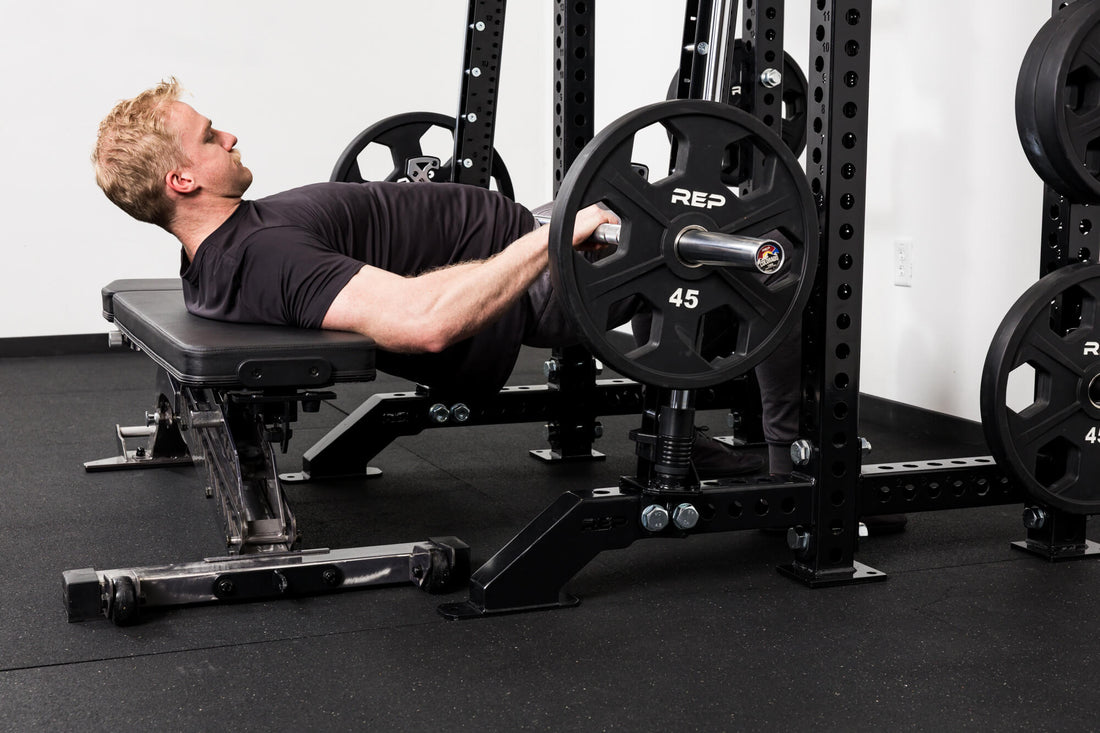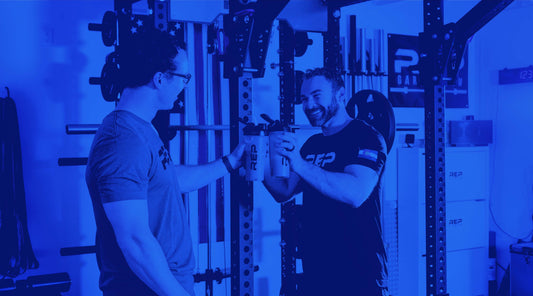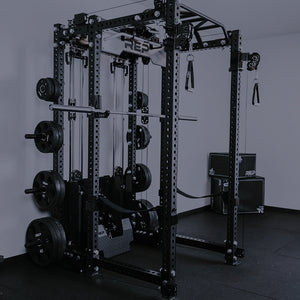
Build-A-Butt
Yes, we know hip thrusts are all the rage — rightfully so, they're a go-to for building strength and size in your glutes. But let's be honest: the setup can feel like a workout in itself. Rolling in a bench, loading plates, and shimmying under the bar? Exhausted before you even get a rep in.
Enter the Smith machine hip thrust. Set the bar height, load your plates with ease, and get right to work on that gluteus bootius.
As a NASM-CPT and beach volleyball player, I know the value of a strong backside — it looks good in a bikini and helps me explode out of the sand. After three years of programming Smith machine hip thrusts, I'll walk you through everything you need to know to start cruising with this glute-growing staple.
Wait... What's A Smith Machine?
The Smith machine — like the REP Smith Machine Attachment, compatible with the home-gym-friendly PR-4000 and PR-5000 power racks (check out the Ares 2.0 Builder to see how it could work with your setup) — is a barbell fixed to a vertical path. Unlike a free-weight barbell, it moves along this set track, which helps stabilize the weight and control the range of motion.
One of the biggest perks is safety: the bar can lock into place at multiple heights, allowing you to lift heavy without a spotter. To unlock (depending on the direction you're facing), simply twist the bar back; to re-rack it, twist it forward until it hooks onto the safety catches. Most Smith machines also have adjustable safety stops that keep the bar from dropping too low.
Because of the guided path, the Smith machine is often used for exercises where stability might be a limiting factor or when you want to really dial in on a muscle group. You'll be able to focus all of your attention on that targeted muscle group since your core and stabilizers won't be fighting to keep you from tipping over.
Smith Machine Hip Thrusts with Proper Form
"As with a barbell hip thrust, proper bench height, spinal alignment, and foot placement are key to avoiding lower back or even knee strain and maximizing glute activation," says Jonathan Flicker, NASM-CPT, CES, and owner of FLICKER STRONG. To keep you pain free and focused on the glutes, here's a quick step-by-step to have you set up and repping with perfect form.
Set Up
- Set the bar close to the ground, about the same height as your bench.
- For comfort, consider adding a pad around the bar for some cushion — a sweatshirt or towel also works in a pinch.
- Bring in a bench situated paralell to the bar and play with placement so the bench supports your upper back when you've lifted your hips up.
How To Do Hip Thrusts on Smith Machine
- Align the bottom of your shoulders on the edge of the bench — making sure this placement allows your upper back to have support as you hinge up.
- Have the bar line up over your upper thighs, just below your hips.
- With your butt on the ground, set your feet about shoulder width apart with knees bent.
- Place hands on the barbell for guidance.
- Squeeze your glutes and drive through your feet to hinge up.
- At the top range of motion, knees should be at 90 degree angles, and spine should be neutral — avoid overextension of the lower back.
Smith Machine Hip Thrust Benefits & Muscles Worked
Hip thrusts have taken the fitness world by storm thanks to their beginner-friendly setup and straightforward progressive overload potential. "One of the biggest benefits of doing hip thrusts on the Smith machine is the convenience of having the bar already in place," says Flicker. "Its fixed path also helps maintain consistent mechanics without the need to worry about balance."
Hip extension is the name of the game here, with the glutes as the primary movers. You should feel the burn primarily in your glutes, but experimenting with foot placement can slightly shift which muscles are emphasized.
Primary Muscles
- Gluteus Maximus: The largest muscle in your body contracts to facillitate that hip extension.
Secondary Muscles
- Hamstrings: Support your glutes to perform the hip thrust.
- Gluteus Medius: Help keep the pelvis stable throughout the lift.
- Gluteus Minimus: Supports hip abduction and stabilization of the pelvis during this move.
- Quadriceps: Play an active role in stabilizing your knee joint and maintaining leg alignment.
- Erector Spinae: These lower back muscles maintain an isometric contraction throughout this lift to keep your spine from rounding.
- Adductors: Help keep your legs aligned and stable during your lift.
Adding this exercise — when performed with proper technique — can increase glute size and strength, improve hip extension power, and even elevate athletic performance.
Smith Machine Hip Thrust Common Mistakes
Flicker's been training folks for decades, and here are some of the most common mistakes he's clocked on the Smith machine hip thrust with his clients over the years.
Pushing Through Toes: You might be tempted to go up on your toes as the weight lifts up, but be sure to keep your entire foot drilled into the floor throughout your rep. You want to drive the weight up by pushing through your heels.
Knees Collapsing: Whether your opt to have your knees flared out slightly, or choose to have them more like train tracks with your feet, make sure they don't collapse in on each other during your reps. This can lead to joint pain.
Foot Placement: Getting your body set up for hip thrusts takes a little trial and error. If your set up has your feet placed too far away, your hamstrings will tap in to tackle more of the work. To keep the focus on your glutes, inch your feet back a hair so you create 90 degree angles at the top range of your hip thrust.
On the other side of that, if your feet start off too close to you, that can put unnecessary stress on your knee joints. Be sure to have your feet set close to you, but not so close that they're forcing your knees to track over your toes when you go up into extension.
Hip Thrust Smith Machine Variations & Alternatives
While we think the Smith machine hip thrust is a staple, substitute in one of these alternative exercises to spice things up and keep the booty burning.
Smith Machine Banded Hip Thrust
The hip thrust's hip extension gets some added abduction action with the use of a loop band wrapped around your thighs. You'll also get some added focus on your gluteus medius (the upper/outter part of your bum) during your hip thrusts.
How To Rep:
- Toss on a glute band, mini loop, or short loop band around both legs just above your knees.
- Perform the Smith machine hip thrust as you typically would, keeping your knees pressed outward on the band throughout your reps.
Tip: You can add some outward flutters — pressing your knees outward against the loops resistance — at the top range of motion to increase the burn.
Smith Machine Single Leg Hip Thrust
Doing unilateral work can help to identify muscle imbalances and fix them. As such, try incorporating single leg Smith machine glute bridges into your routine.
How To Rep:
- Setup how you would for a standard Smith machine hip thrust.
- When you're ready to start your reps, lift one leg off the floor. The opposite leg that's planted will be your working leg.
- Drive off the floor with your planted foot, allowing your non-working leg to travel up with your body.
- Complete your reps then switch sides.
Tip: This is similar to a staggered stance hip thrust, however with the staggered stance variation you'll keep your non-working leg extended away from you and in contact with the floor throughout the movement.
Smith Machine Donkey Kicks
While this move primarily targets the gluteus maximus, you'll also get some engagement in your hamstrings, core, and shoulders as you work one side and then the next.
How To Rep:
- Set the bar a little lower than hip height.
- Kneel on all fours facing away from the bar.
- Place the arch of your foot under the bar, maintaining balance on your hands and opposite knee.
- Push the bar up as you extend your knee, avoiding an excessive amount of arch in your spine.
Smith Machine Frog Pump
Think of this lift as a glute activation and burnout move rather than a PR-chasing exercise. It's ideal for days when you're prioritizing other lower-body compound lifts but still want to thourougly fatigue your glutes.
How To Rep:
- Set up with a bench running perpendicular to the bar, with the bar positioned about a foot or so above the bench.
- Lie back against the bench with the bar across your hips, knees bent, and the soles of your feet together so they're touching and your knees flare outward.
- Drive through your glutes to thrust upward, then lower with control.
Tip: Use a lighter load than you would for a standard hip thrust. Perform higher reps and work close to failure for maximum glute burn.
Takeaway
If there's one move you try on the Smith machine, let it be the Smith machine hip thrust. Compared to its free-weight counterpart, it's easier to load and easier to setup — saving you time and energy so you can focus on building that cake. Plus, the fixed bar path gives you stability to drive harder through your glutes, making every rep count.
FAQs
Can Smith machine hip thrusts help build my glutes?
Yes! Hip thrusts are one of the best exercises for targeting and strengthening the glutes. Using a Smith machine to perform this move provides stability, making it easier to focus on driving the weight up. If you're looking to build size, aim for a hypertrophy rep range of 6-12 reps (65-80% of 1RM), and if strength is the goal, work in a 1-6 rep range (80-95% of 1RM).
How should I warm up before Smith machine hip thrusts?
To avoid injury and prime your muscles for the work ahead, always start things off with a proper warm-up. Begin with a few minutes of light aerobic activity to raise your heart rate, then move into dynamic stretches, such as walking lunges or hip circles, to open up your hips. Since the Smith machine hip thrust primarily targets your glutes and hamstrings, give those muscles a little TLC before you start your working set — this can include doing a warm-up set at a lighter weight to activate the muscles and lock in your form.
What should I do if the Smith machine bar hurts my hips during hip thrusts?
You're not alone! The heavier you go, the more pressure you'll feel on your hips. To ease the discomfort, use a bar pad, sweatshirt, or whatever cushioning you have on hand. This will help to protect your hips and keep the pain from cutting your sets short. If you don't have any cushioning, try pushing the bar slightly down into your thighs as you lift — this can shift some of the pressure from your hips to a meatier part of your leg.
Rosie Borchert is NASM-CPT, former Nike Volleyball coach, and fitness writer whose work has appeared on BarBend and Tonal. If anyone would like to hire her to play beach volleyball, snowboard, binge watch TV, or go climbing, please get in touch.
This article was reviewed by Ashley Boyer, ACE-CPT, for accuracy.

NEWSLETTER SIGNUP
Product launch information, promotions, blogs, and REP news.







